ashleytrainor
5 posts
Don't wanna be here? Send us removal request.
Text
Final Exam Reflection
1. We took the metro line 5 to Boulevard Voltaire in the 11th arrondissement which was an interesting site to visit as it was very close to Place de la Republique which we visited a few days prior. This boulevard begins at Place de la Republique and ends at Place de la Nation, spanning 2,850 meters (1). There are many streets that intersect with it, making it a major roadway in the city that houses a variety of shops and restaurants. We walked down this boulevard while going to the next metro station starting at Place de la Republique and used it as an opportunity to look at the shops and the people that walked along the sidewalks.
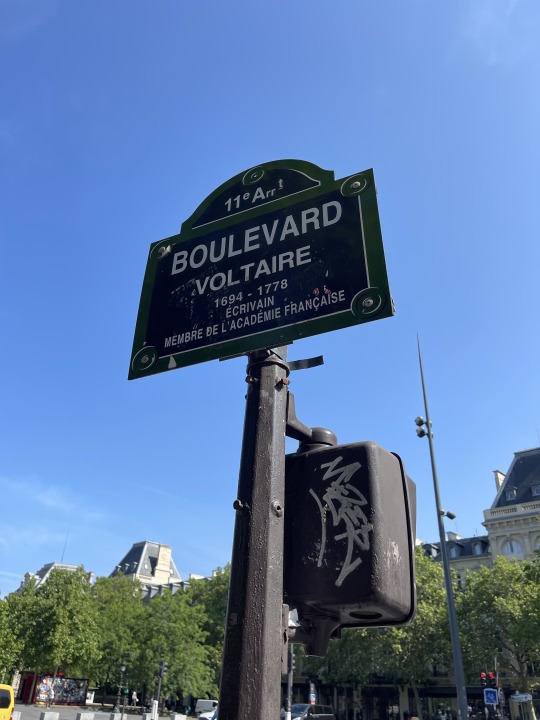
2. In the 6th arrondissement, we searched for the sundial. We followed directions based on the location given on our worksheet, putting it into google maps and also our RATP app. When we were walking, I was looking around enjoying the scenery, and I noticed some interesting art on the buildings. Eventually, our directions told us we had passed the sundial’s location. Confused, I looked up a picture of the sundial online so I knew what exactly we were looking for since I wasn’t even sure what a sundial looked like. When the pictures came up, I realized I had already seen it on the buildings we passed and thought it was just some weird-looking art. We backtracked and were able to find it on the corner of a building next to a restaurant. Upon further research, we found out that Paris has 120 sundials, and Salvador Dalí designed this particular sundial as a present to his friends who owned a boutique at the address number 27 rue Saint-Jacques (French Moments).

3. After taking metro 5 to the Jardin de Plantes was very easy to find in the 5th Arrondissement, as it was just 900 feet from the Gare d’Austerlitz station. Inside, the Garden was very large and all the sites seemed spaced out. Overall, the Jardin de Plantes contained 11 gardens, 6 main places to visit within, and even adorable cafe stands scattered throughout. From additional research, we learned the garden's main attractions include its beautiful gardens (of course), library, exhibitions, gallery, and zoo that was founded largely due to the animals brought from the Palace of Versailles (2). Since we were instructed to find the zoo specifically, we found a map near the front gates and discovered “Menagerie” which refers to the collection of wild animals, and followed the signs posted from there to locate the zoo’s entrance. While the garden itself is free, it does cost 10-13 euros to see the zoo animals. Inside, the Jardin de Plantes Zoo houses around 150 different species of animals, including some of our favorites: kangaroos, flamingos, and snow leopards (2)
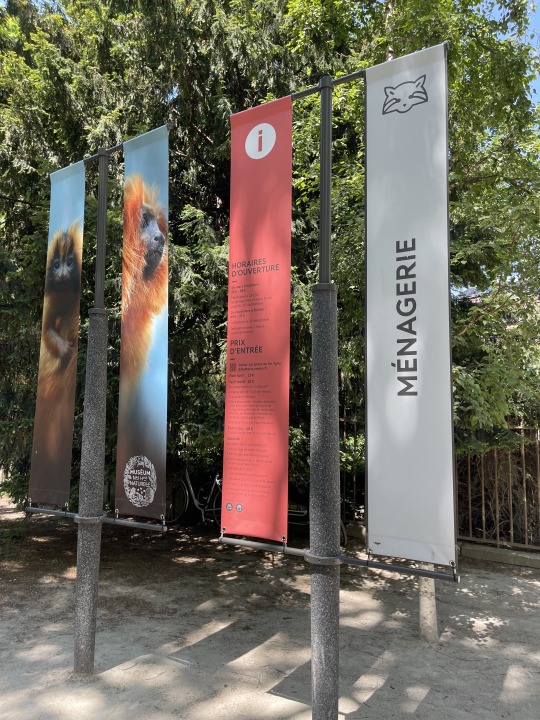
4. From Boulevard Voltaire, we took metro line 4 to Saint Sulpice church as we searched for Rimbaud’s “Le Bateau Ivre”. We walked through a square in front of the church to a side street with a large wall that the poem was written. This poem spans 300 meters across a wall written in large lettering with the author’s name being displayed twice near the end of the poem (2). The poem is one-hundred lines long and tells the story of a sinking boat and reflects the struggles of Rimbaud himself in his career as a poet. This poem is considered to be his greatest work and has been memorialized on the wall on 4 rue Ferou.
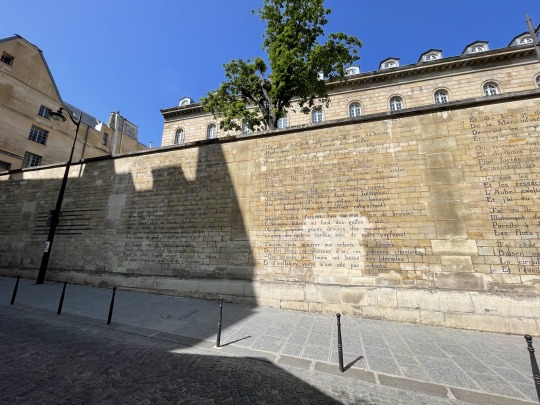
5. During our travels in between locations, we passed through the Place de République, which houses a large monument at the center. At the top of the monument is a statue of Marianne, wearing the Phrygian cap and holding an olive branch. The Phrygian cap is a symbol of freedom, and the olive branch is a symbol of peace. Her second hand is resting on a tablet, and the tablet says “human rights”. This monument was erected in 1883 and represented freedom and the history of people fighting for freedom and rights in the French Republic. We found it really awesome that the symbol of Marianne is so meaningful to the French people that a statue of her this large was erected.

6. Montparnasse Cemetery, located in the 6th Arrondissement was very lovely to visit. As we entered its main gates, we first noticed how wide and straight streets were. This was rather eye-catching to us since the dirt roads were very different from the cobblestones in the Père Lachaise Cemetery. Nevertheless, we found the grace of Jean-Paul Sartre and Simone de Beauvoir just right of the cemetery’s main entrance. The grave itself was designed in a very typical fashion: a rectangular base and a headboard piece with the names and lifespan of the deceased listed, however, it was covered in many unusual markings. All across the back headpiece, as well as along the base, pink and red colored kids' marks, hearts, and other love-related designs were drawn with what appeared to be crayons or lipstick. After researching the reasoning behind the markings we learned that Jean-Paul Sartre and Simone de Beauvoir were the first pair of known models of an open relationship. The pair never owned a home together but would instead meet daily at cafes to converse, gossip about their other partners, and edit each other's work (6). Supposedly, the two were both writers and never published a piece without the other’s input. While there are many more dramatic details to read further into the lives of Jean-Paul Sartre and Simone de Beauvoir, their legacy left behind is ionic for its pushback against social norms, as well as the questions it raises regarding what love looks like.
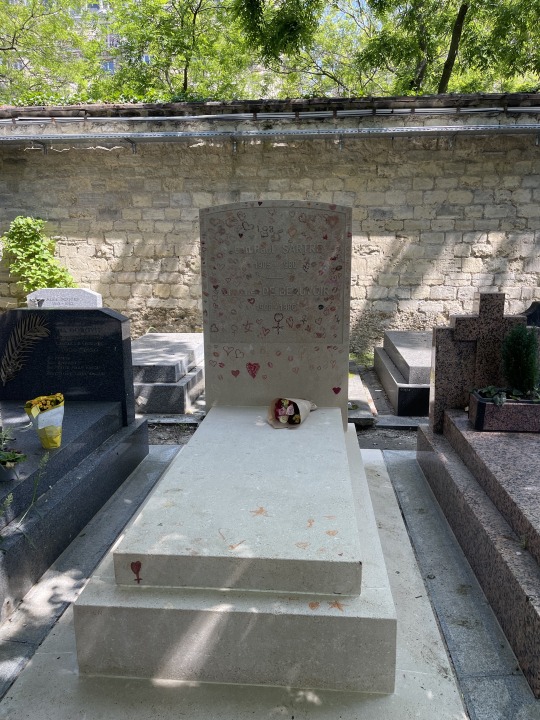
7. We walked from Parc des Buttes Chaumont to the top of Passerelle Bichat, the pedestrian bridge that crosses Canal St. Martin. This bridge was very unique to walk across in that it was not shaped or structured like a typical bridge. It was much higher than expected and seemingly came to a point at the top of the steep stairs. The Canal St. Martin that it crosses over was created in the 1820s and was intended to provide clean drinking water to the city (3). There is a park on one side of the bridge with an area for children to play and it seems to be located in a more residential area of the city.
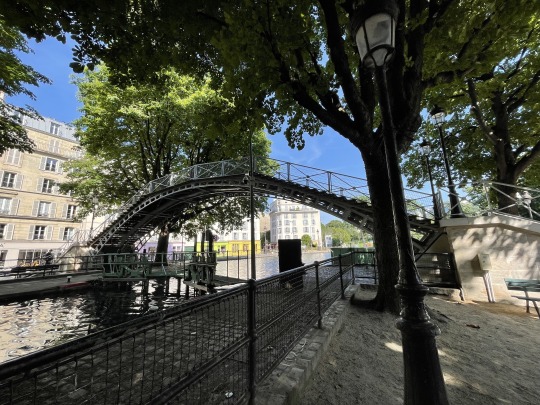
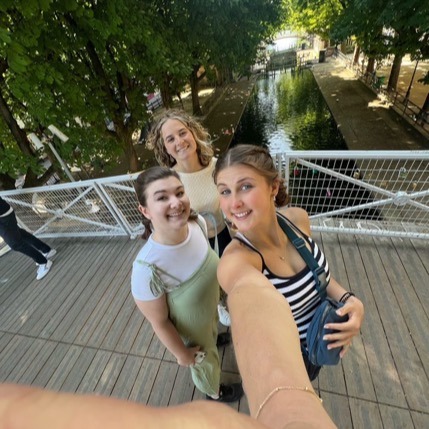
8. The first place that we went was to the Temple of the Sibyl in 19e. The temple is in the Parc des Buttes Chaumont, which is a beautiful green area with trails for walking, a large green hill for hiking or sitting for a picnic, an island with the temple, and a waterfall. The temple sat at the highest point of the island. Unfortunately, when we went to the bridges to get on the island, the island was blocked off and we were unable to enter and get on the island to get a closer look at the temple. The temple looked to have a Romanesque design to it and was inspired by the Temple of Vesta in Tivoli, Italy (Ackteon, Paris – Buttes Chaumont – Le temple de la Sybille, Flickr).

9. This Maille brand mustard was found in a Franprix grocery store located on Avenue de Laumiere. While the grocery store as a whole was dairy small in size, it seemed to have everything in stock that a Parisian would need to cook a nice meal. Within the store, we found the mustard in one of the aisles that were specific to condiments, similar to the grocery stores in the US. At first glance, we were all surprised by the faint yellow color of the mustard.

References
(1) “Origin and History of Boulevard Voltaire.” n.d. Accessed May 27, 2023. http://www.evous.fr/Origine-et-histoire-du-Boulevard-Voltaire,1161616.html.
(2) “Paris: Le Bateau Ivre Fresco by Arthur Rimbaud, Rue Férou Illuminated by the Words of the Poet - VIème - Paris La Douce, Parisian Magazine Lifestyle, Culture, Outings, Street Art.” n.d. Accessed May 27, 2023. https://www.parisladouce.com/2020/10/fresque-le-bateau-ivre-paris-rue-ferou.html.
(3) Paris, Office du Tourisme et des Congrès de. n.d. “Balade Du Canal Saint-Martin à La Villette Paris - Office de Tourisme Paris.” Accessed May 27, 2023. https://www.parisinfo.com/decouvrir-paris/balades-a-paris/paris-de-belleville-a-la-villette.
(4) Ackteon. (n.d.). Paris – Buttes Chaumont – Le temple de la Sybille. Flickr. https://www.flickr.com/photos/73553452@N00/8748730408
(5) Pierre. (2020, June 13). Where to find the Salvador Dali Sundial in Paris - French Moments. French Moments. https://frenchmoments.eu/salvador-dali-sundial-paris/ (6) “Simone de Beauvoir et Jean-Paul Sartre, Un Couple Mythique de La Littérature.” 2014. Www.Rtl.Fr. January 9, 2014. https://www.rtl.fr/actu/simone-de-beauvoir-et-jean-paul-sartre-un-couple-mythique-de-la-litterature-7768645019.
@haleylongcore @nataliedeal02
0 notes
Text
Entry #4: Parisian Lifestyle

There are several gardens that I have visited outside of class, including the Luxembourg Gardens in the 6th arrondissement. These gardens were constructed at the wish of Queen Marie de Medici in 1612 (1). There is a palace amongst the gardens which were constructed in the style of gardens in Florence. In observing the ongoings within this large park, it was interesting to see all that people were doing with their time. The park was very full on a weekday and I saw many people walking through the gardens enjoying the scenery. I also noticed several people running or walking their dogs. There were also many people in the park having picnics, likely eating snacks as we went to the park around 5:00 in the evening. There were many tourists present in the park but there were also many Parisians who were enjoying their evenings in a place of nature. In both this park and others that I was able to sit in or picnic at, I noticed many Parisians enjoying meals with friends or coworkers in the grass or on benches. Being able to observe the lifestyle of Parisians where it is common to have a leisurely lunch or snack on a weekday in a park was a different experience than what I have observed in the United States. In the United States, weekdays are driven by work and this affects the time one spends eating lunch, often causing them to work while eating or to take a very fast lunch. The two cultures are very different as France restricts work weeks to 35 hours while people in the U.S. often work 40 hours or more in a week.

In observing Parisians in general, I have noticed that they spend time in cafes, restaurants, and parks throughout the entire day. In the early mornings, there are many Parisians getting pastries and drinking coffee at cafes or getting baked goods for breakfast at boulangeries. From 12:00 to 2:00 in the afternoon, one can see Parisians sitting in cafes or in parks eating lunch with coworkers or friends. They socialize for long periods while on their lunch breaks and drink water, coffee, or wine with their lunches. From around 8:00 to 11:00 in the evening, Parisians can be seen eating dinner at restaurants or cafes, eating several kinds of food and often drinking wine with dinner. Meals tend to be long which allows for slow eating and socialization without the stress of being rushed out of a restaurant. This differs significantly from the United States as restaurants often want to provide to as many customers as possible and customers often want to eat fast meals. While being here, I have greatly appreciated being able to take my time with my meals and being able to live a slower lifestyle when eating.

In class, we learned that France leans towards having a socialist government that provides proper support for the people of the nation. They provide livable wages, 35-hour work weeks, and retirement pensions, among other things that make the lives of the French people easier. There is much more of a “work/life balance” in France as they work for fewer hours in a week and most French people do not value work over their personal lives. When they are outside of work, they do not spend much time discussing their work lives and instead focus on leisure or their family lives which they tend to value more. In France, it is easier to have this because of respect for working people and the benefits that are available to workers as compared to the U.S. where one must work to live comfortably. In relation to what we have learned about French history and politics, this lifestyle makes sense as the government provides the French people with comfortable lives if they seek it out. This can be tied back to the French Revolution as the people of the nation originally revolted against a French monarchy that did not value the lives of citizens. Since the 1789 revolution, the French people have continued to fight against the government for their right to live comfortable lives which has led to the lifestyle of Parisians. (707 words)

(1)Bureau, Paris Convention and Visitors. n.d. “Jardin Du Luxembourg - Paris Tourist Office.” Accessed May 27, 2023. https://en.parisinfo.com/paris-museum-monument/71393/Jardin-du-Luxembourg.
1 note
·
View note
Text
Entry #3: Religion

In my time here, I have had several experiences with religion in Paris that showcase the religious prominence and diversity within the city. We went into Paroisse Saint Paul Sain Louis Marais church which was built from 1627 to 1641 in the Marais. This church is located between shops on the Rue Saint-Antoinne and draws people in with its large red doors and beautiful architecture. We went in at a time when mass was not going on but we were able to appreciate the beauty and spiritual value of this church. It is clear that Catholic and Christian traditions, churches, and religions are well established within Paris and have been present for a long time when looking at these places of worship. Attending mass at St. Eustache was a very valuable experience as I was able to spend time in a beautiful and historic place of worship. It was very interesting to sit through mass where I was unable to understand what was being said but still understand the rituals that occur during Catholic mass. This allowed me to reflect on the universality of religion, in this case, Christianity, and to understand that feeling close to God during worship is all that is necessary for individual spirituality. Being able to stare at the stonework, stained glass, and paintings that adorn St. Eustache during mass showed me how the architecture makes one feel smaller than God while providing comfort in one’s relationship with God.

Visiting the Grande Mosquée de Paris was a very interesting experience as I had never been to a mosque before. I have learned about Islam through Muslim friends and a world religion class but seeing an Islamic place of worship in person was beneficial in furthering my understanding of the religion. Being able to see the architecture of the building, the prayer rooms, the gardens, the calligraphy, and the tile work helped me to further understand the importance of not having artistic representations of their religion outside of calligraphy so they do not worship idols or disrespect their faith in any way. I have not lived in cities that have much religious diversity in my life so being able to spend time in Paris, a religiously diverse city, has allowed me to understand religion better as a whole. My own faith has not been directly impacted by the city but my understanding of the importance of respecting all people’s religions has been strengthened as I have seen how important it is to a diverse group of individuals. In reflecting on religious diversity in the city of Paris, it is interesting to see the number of individuals wearing religious attire even though France is a secular nation. In several public places, I saw women and girls wearing Hijabs which was not something that I expected to see as much as I did given the several laws that have been passed against women wearing this attire in state buildings. French laicité is seemingly the freedom from religion within France that makes this nation a secular one. It can be seen in the lack of religious imagery in governmental areas but this imagery is very present throughout Paris in famous artwork, historic buildings, and the chapels that are scattered throughout the city. It is also apparent that people proudly and outwardly show their religion through attire or their attendance at worship services for their religion. Although it does not seem to be a large issue, this does go against laicité because religion is still very visible in the city of Paris. (591 words)


0 notes
Text
Post #2: On Pere Lachaise Cemetery
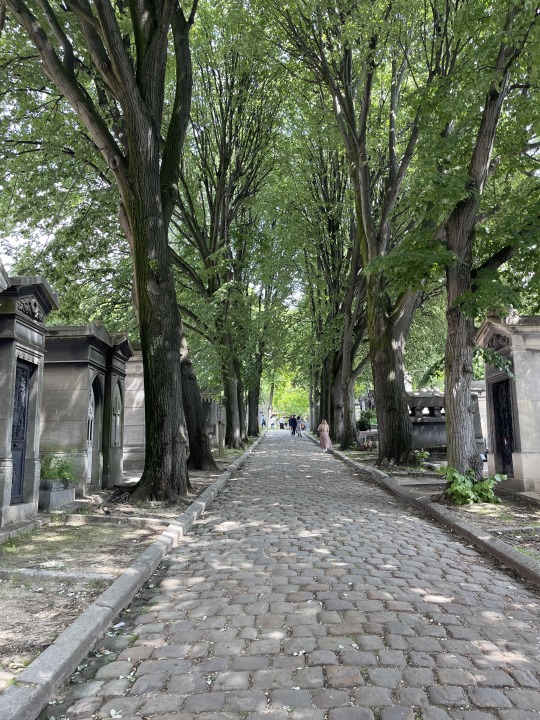
Overall, experiencing Pere Lachaise was very interesting as I had never spent an extended period of time in a cemetery and had never been to one as large or historic as this. This is a place of many memories as it holds so many people who have passed and memorializes many others that were unable to be buried at the cemetery. The Paris Commune in 1871 saw several victims in this cemetery after they lost a battle and were shot against a wall within the cemetery. There are also many famous individuals buried at this cemetery which increases the number of visitors who come to remember those who have passed. Walking along the cobblestone paths amongst the tombs and memorials was something that was very interesting as I was very aware that I was in a place of remembrance that must be respected. While walking through the pathways and up the hills, I came to an overlook with flower beds that had the appearance of a park. This was something that was unexpected as I did not think of this cemetery as a place where people would spend time outside of remembering those who had passed. The cemetery was a beautiful place overall with its trees, historic tombs, flowers, and cobblestone paths but it is also important to remember its true purpose as a cemetery. There was a lot of diversity in the tombs as there were more simplistic tombstones, large memorials for individuals or groups of individuals, and mausoleums. It was interesting to consider why some individuals had more extravagant burial places and we speculated that it could have been the result of wealth. It was also interesting to see which tombs had flowers or other things on them and which were left empty or were left in disrepair.
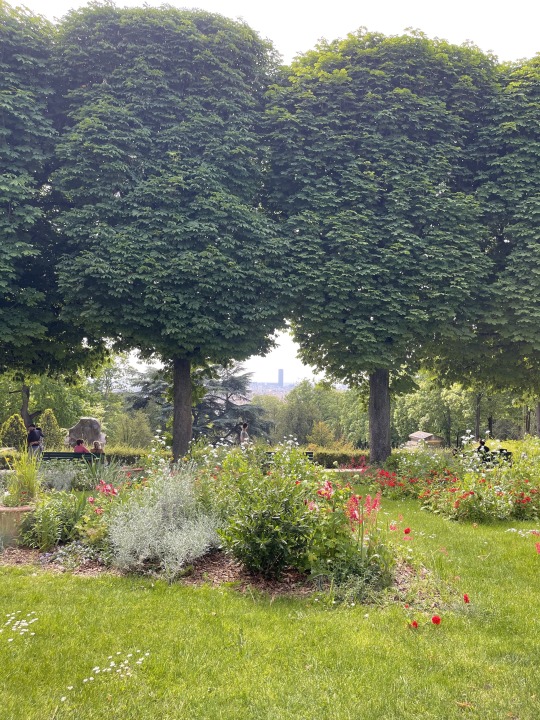
The Holocaust memorials at the Pere Lachaise cemetery were particularly striking and heartbreaking to see. The specific area dedicated to those lost in the Holocaust houses fifteen memorials, for each of the deportation and death camps (1). During the Nazi occupation of Paris and the Second World War, 75,000 Jewish people were deported and sent to camps with many of them losing their lives. There are memorials specifically dedicated to Dachau, Auschwitz, Buchenwald, Oranienburg and Sachsenhausen where many Jewish people throughout Europe were deported, many of which lost their lives in the camps (2). Several of these memorials depict skeletons or imagery of death to recognize the horrors that so many were forced to go through at these camps. In particular there were two memorials that were located next to each other that I found to be very striking. The first memorialized the Jewish children who were killed by the Nazi’s during world war two and depicts human-like shapes shown in metal. The anonymity of the figures helps to show that many of the victims of these horrors are still unknown and that they are being memorialized as they are not buried in this spot. Next to it is a memorial for two concentration camps, Buna-Monowitz and Auschwitz, remembering the lives lost at these sites. This memorial depicts five skeleton-like figures in bronze, all with fatigued body language and with one being wheeled. This shows the suffering and horrors that the victims of these camps had to go through in their time. Walking through this area of the cemetery was a somber experience but an important one as the horrors that so many Jewish people had to undergo must be remembered. (582 Words)
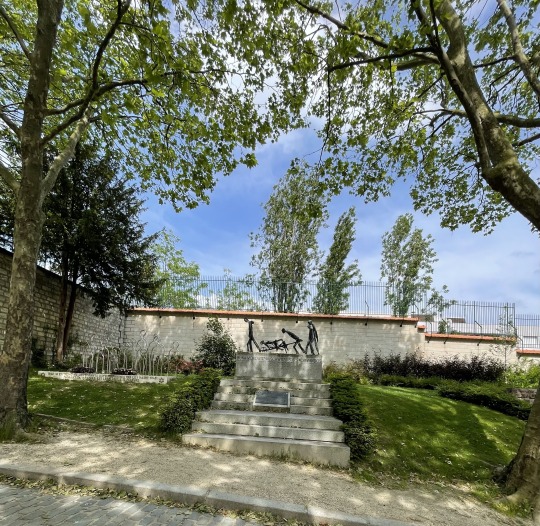
(1) “Cimetière Du Père-Lachaise : Un Haut Lieu de Mémoire.” n.d. Accessed May 25, 2023. https://www.paris.fr/pages/cimetiere-du-pere-lachaise-un-haut-lieu-de-memoire-17725. (2) “Holocaust Memorials at Père Lachaise Cemetery, Paris, France.” 2015. Historic Houston: (blog). June 26, 2015. http://historichouston1836.com/holocaust-memorials-at-pere-lachaise-cemetery-paris-france/.
0 notes
Text
Post #1: On Experiencing Art Museums

In the time we have been in Paris thus far, we have been able to see artwork at both the Louvre and the Musee d’Orsay. Overall my experiences at both museums were incredible as I was able to see pieces of art that I had viewed for my whole life on a computer screen or in a book. I was also able to experience new artworks that were equally as influential and beautiful including several works by Jaques Louis David that I had not seen before. In the Louvre, seeing The Great Odalisque and learning about its history was very interesting.

In the Musee d'Orsay, I found Luncheon on the Grass by Edouard Manet, created in 1863, to be a particularly fascinating painting. Being able to listen to Dr. Kraus explain the painting and further researching the elements of design in this artwork has helped me to understand the meaning of this painting. This oil on canvas painting in the realism style depicts four people, two men and two women in a forest with water near them. Three of the individuals appear to be having a picnic while one is seen walking towards them from the other. The people in this painting fill most of it with their belongings and fruit filling the space near them. There is negative space in the painting that is filled with the green space of nature, grass, and trees. The women are shown being cast in bright light with shadows being seen under parts of their bodies, giving a more three-dimensional appearance. The proportions are off in this painting, indicating that the perspective is also off as the man’s thumb is larger than normal and the woman in the back appears to be too large for the distance she is at. The people are arranged in a triangular perspective with the woman in white being at the top of the triangle. The main colors shown in this painting are the blue of the woman’s clothes, the green of the surrounding nature, the beige of the people’s skin, as well as the brown and black of the men’s clothing. The painting shows heavier brushstrokes which is indicative of the Realism style and show that it has moved past the neoclassical style of smooth paintings. It is of particular interest that the two men are completely clothed while the woman sitting with them is fully naked and the other woman is dressed more provocatively for the time. The naked woman sitting with clothed men makes this piece provocative and suggests an absence of classical context. At the time of this painting, this was very problematic as the naked woman was a modern female rather than the goddesses who were celebrated when nude. This painting was Manet’s refusal to conform to academic art as he painted a scene of everday life with a naked modern woman.

Prior to this program, I had an appreciation for art that was very surface level as I was only able to look at it and appreciate its beauty without knowledge of the elements of design that are so crucial to art. Learning these things in class and applying this newfound knowledge to the art pieces I have been able to see in person has strengthened my appreciation for the art itself. I have found that I understand the perspective of the artist better and can determine the meaning that the artist intended when creating the artwork. I grew up with a parent who wanted to instill an appreciation for art in me from a young age and this was something that I have developed over time but being able to understand the art on a deeper level has strengthened my appreciation for it significantly. (636 Words)
2 notes
·
View notes